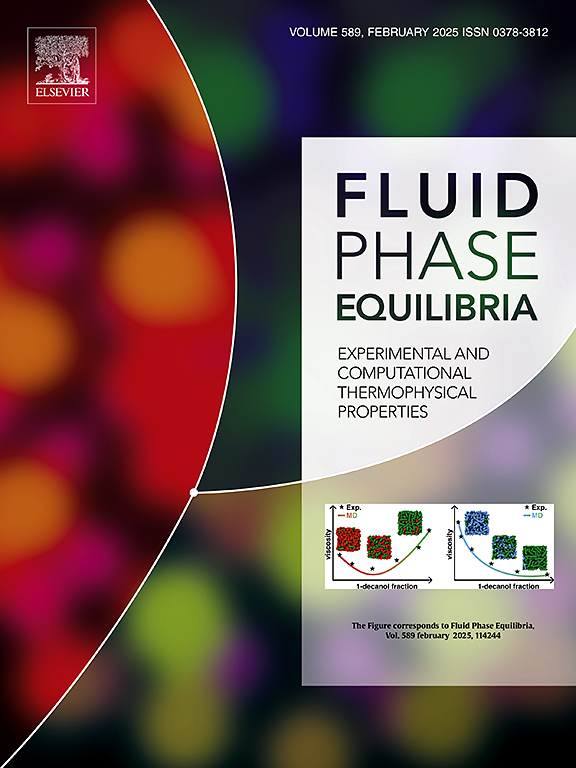A stable solution method for natural gas density across a wide temperature range using the GERG-2008 equation of state
IF 2.8
3区 工程技术
Q3 CHEMISTRY, PHYSICAL
引用次数: 0
Abstract
The GERG-2008 Equation of State (EoS) is recommended by ISO 20765–2 for computing the physical properties of natural gas. Due to the non-monotonic relationship between pressure and molar density described by the GERG-2008 EoS under low temperature conditions, multiple density solutions may exist, making the precise determination of density challenging. This paper first investigates the variation of molar densities with pressure at different temperatures. When the temperature is above (The composition-dependent reducing functions of the mixture temperature), the pressure described by the GERG-2008 EoS increases monotonically with the molar density, and only one molar density solution that satisfies the equation exists. However, when the temperature is below , the pressure described by GERG-2008 EoS no longer changes monotonically with the increase in molar density, resulting in multiple molar density solutions that satisfy the equation. To address this problem, this paper proposes a novel solution method that employs a combination of one-dimensional search and the Newton-Raphson iteration to obtain the required molar density solutions. The true molar density solution is then determined based on the Gibbs free energy criterion, ensuring the correct molar density solution is obtained across a wide temperature range. A total of 903 sets of natural gas density data, covering pressures from 0 to 200 MPa and temperatures from 100 to 450 K, were used to validate this method. The computational results indicate that, when the temperature is above, the average relative deviation (ARD) between the calculated density values and the experimental values ranges from 0.1 % to 0.59 %. For temperatures below , the ARD values using this method range from 0.01 % to 0.39 %. The proposed solution method enhances the stability and accuracy of solving the GERG-2008 equation, particularly for natural gas at low temperatures.
利用geg -2008状态方程求解大温度范围内天然气密度的稳定方法
geg -2008状态方程(EoS)被ISO 20765-2推荐用于计算天然气的物理性质。由于geg -2008 EoS描述了低温条件下压力与摩尔密度之间的非单调关系,因此可能存在多种密度解,这给密度的精确测定带来了挑战。本文首先研究了不同温度下摩尔密度随压力的变化。当温度高于Tr(x)(混合物温度的组分依赖还原函数)时,由geg -2008 EoS描述的压力随摩尔密度单调增加,并且只有一个摩尔密度解满足该方程。然而,当温度低于Tr(x)时,由geg -2008 EoS描述的压力不再随摩尔密度的增加而单调变化,从而产生满足方程的多个摩尔密度解。为了解决这一问题,本文提出了一种新的求解方法,采用一维搜索和牛顿-拉夫森迭代相结合的方法来获得所需的摩尔密度解。然后根据吉布斯自由能准则确定真正的摩尔密度溶液,确保在很宽的温度范围内获得正确的摩尔密度溶液。903组天然气密度数据,覆盖压力从0到200 MPa,温度从100到450 K,用于验证该方法。计算结果表明,当温度高于r(x)时,计算密度值与实验值的平均相对偏差(ARD)在0.1% ~ 0.59%之间。对于低于Tr(x)的温度,使用该方法的ARD值范围为0.01%至0.39%。提出的求解方法提高了求解geg -2008方程的稳定性和准确性,特别是对低温天然气的求解。
本文章由计算机程序翻译,如有差异,请以英文原文为准。
求助全文
约1分钟内获得全文
求助全文
来源期刊

Fluid Phase Equilibria
工程技术-工程:化工
CiteScore
5.30
自引率
15.40%
发文量
223
审稿时长
53 days
期刊介绍:
Fluid Phase Equilibria publishes high-quality papers dealing with experimental, theoretical, and applied research related to equilibrium and transport properties of fluids, solids, and interfaces. Subjects of interest include physical/phase and chemical equilibria; equilibrium and nonequilibrium thermophysical properties; fundamental thermodynamic relations; and stability. The systems central to the journal include pure substances and mixtures of organic and inorganic materials, including polymers, biochemicals, and surfactants with sufficient characterization of composition and purity for the results to be reproduced. Alloys are of interest only when thermodynamic studies are included, purely material studies will not be considered. In all cases, authors are expected to provide physical or chemical interpretations of the results.
Experimental research can include measurements under all conditions of temperature, pressure, and composition, including critical and supercritical. Measurements are to be associated with systems and conditions of fundamental or applied interest, and may not be only a collection of routine data, such as physical property or solubility measurements at limited pressures and temperatures close to ambient, or surfactant studies focussed strictly on micellisation or micelle structure. Papers reporting common data must be accompanied by new physical insights and/or contemporary or new theory or techniques.
 求助内容:
求助内容: 应助结果提醒方式:
应助结果提醒方式:


